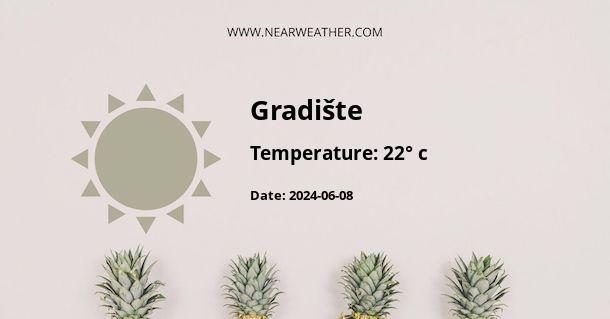Climate and Weather Overview of Gračišće, Croatia
The picturesque village of Gračišće is situated in the heart of Istria, Croatia's westernmost peninsula. Known for its historic charm and scenic landscapes, this area also boasts a distinct climate that is shaped by its geographical location by the Adriatic Sea and the surrounding topography. Understanding the weather patterns of Gračišće and its surrounding regions is crucial for the local agritourism, viticulture, and for visitors who wish to experience the area's natural beauty throughout the different seasons.
Geographical Setting
Gračišće's position on the Istrian peninsula confers a Mediterranean climate that is characterized by warm, dry summers and mild, wet winters. The proximity of the Adriatic Sea regulates the temperature, preventing extreme hot or cold weather conditions. The terrain, which includes rolling hills and valleys, can introduce microclimates that vary slightly from the general regional weather patterns.
Seasonal Weather Patterns
- Spring: The spring season is a transitional period, with temperatures gradually rising and precipitation beginning to decrease. The average temperatures range from lows of 8°C to highs of 17°C in April, providing a pleasant climate for outdoor activities.
- Summer: Summers in Gračišće are typically warm and sunny, with average temperatures ranging from lows of 17°C to highs of around 28°C in July and August. Visitors can expect the majority of summer days to be conducive to spending time on the nearby beaches or exploring the local countryside.
- Autumn: The autumnal months bring cooler temperatures and increased rainfall, making it an ideal time for tourists who prefer a milder climate and fewer crowds. Average temperatures can vary from lows of 11°C to highs of 22°C in October.
- Winter: Winters are generally mild with occasional cold spells. Snow is rare in the region, but rainfall is common. Average temperatures in January range from lows of 1°C to highs of 10°C.
Climate Data
Let's review some climatological data to better understand the weather patterns of Gračišće:
The annual average temperature in Gračišće ranges from approximately 6°C in the colder months to 25°C in the warmer months. Over the year, the temperature typically varies from 2°C to 30°C and is rarely below -3°C or above 33°C.
| Month | Temperature (°C) | Precipitation (mm) |
|---|---|---|
| January | 2 - 10 | 78 |
| February | 3 - 11 | 70 |
| March | 6 - 14 | 65 |
| April | 8 - 17 | 70 |
| May | 13 - 22 | 65 |
| June | 16 - 26 | 56 |
| July | 17 - 28 | 49 |
| August | 17 - 28 | 63 |
| September | 14 - 24 | 85 |
| October | 11 - 22 | 98 |
| November | 7 - 16 | 119 |
| December | 3 - 11 | 112 |
Wind Patterns and Humidity
Wind patterns play a significant role in the climate of Gračišće. The region experiences a bora wind, a cold and dry northeasterly wind, which can occur throughout the year but is most common in the winter. The bora wind often brings clearer skies and cooler temperatures. Alternatively, the sirocco, a warm and moist southeasterly wind, affects the area when it originates over the Adriatic Sea and can bring rainfall and increase humidity levels.
Climate Change Considerations
Climate change is having an observable impact on the weather patterns of the Mediterranean region, including Gračišće. Research indicates that there is a trend toward warmer temperatures and altered precipitation patterns. Increasing temperatures can lead to more frequent and severe heatwaves in the summer months, while changes in precipitation could affect the agricultural cycle of the region.
Factors Influencing Agricultural Practices
The weather and climate of Gračišće have a direct influence on the local agronomy. Istria is known for its olive groves, vineyards, and truffle-bearing forests, all of which rely on the specific climate conditions of the region. Temperature, rainfall, and the timing of seasonal changes are crucial to crop health and productivity. Mild winters allow for an extended growing season, while the warm and dry summers are conducive to the cultivation of olives and grapes necessary for producing high-quality olive oil and wine.
Local Architectural Infrastructure
The traditional architecture of Gračišće reflects its climate. The construction of houses with thick stone walls and natural materials demonstrates historical adaptations to the Mediterranean climate, providing insulation against both warm and cool temperatures. Current building practices continue to evolve to provide comfort while minimizing energy consumption, integrating modern technology with the traditional Istrian aesthetic.
Tourism and Best Times to Visit
While Gračišće is a year-round destination, the best time to visit depends on personal preferences related to weather conditions. For those looking to enjoy the warm and sunny climate, the summer months are ideal. However, for travelers who prefer to avoid the peak tourist season and experience the region's natural and cultural events, the mild temperatures of spring and autumn provide a pleasant alternative.
Weather-Related Events and Festivals
The pleasant weather of Gračišće supports a range of local festivals and events throughout the year which celebrate Istrian traditions and culture. These include wine festivals, olive oil tastings, and truffle fairs, all deeply rooted in the region's agricultural heritage and favored by the local climate.
Conclusion
In summary, Gračišće enjoys a Mediterranean climate with all the charms and challenges that come with it. Its weather patterns play an integral role in defining the lifestyle, culture, and economy of the area. By understanding these climate characteristics, one can better appreciate the uniqueness of Gračišće, its allure for tourists, and its importance as a center of gastronomic and agricultural excellence within Croatia.
A - Gradište's Latitude is 45.148060 & Longitude is 18.706671.
A - Weather in Gradište is 8° today.
A - Climate Conditions in Gradište shows clear sky today.
A - Humidity in Gradište is 89% today.
A - Wind speed in Gradište is 10.58 km/h, flowing at 97° wind direction. today.
